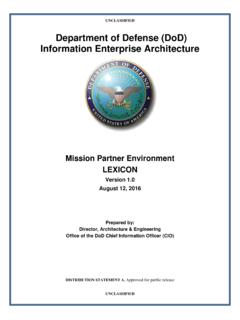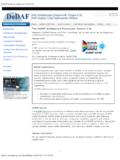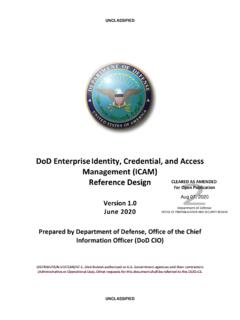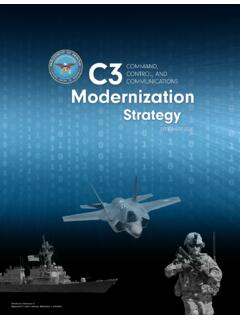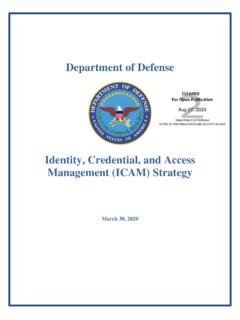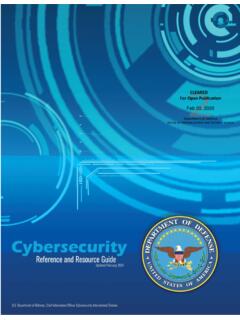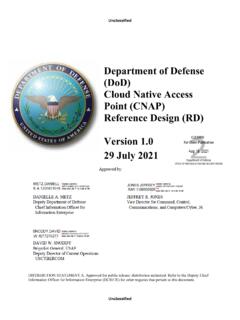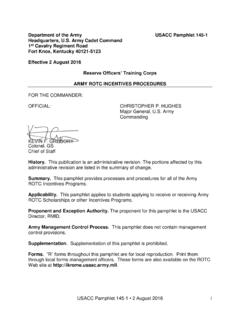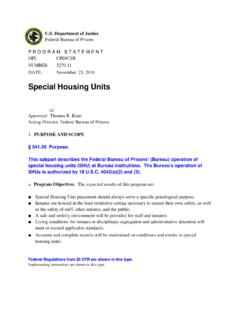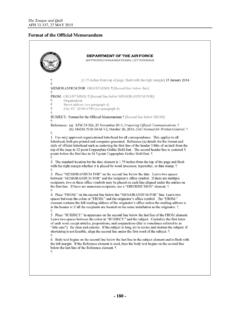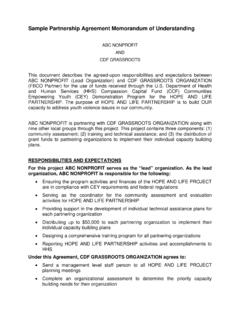Transcription of DoD CIO Memo for Senior Pentagon Leadership
1 DEPARTMENT OF DEFENSE 6000 DEFENSE Pentagon WASHINGTON, 20301-6000 JAN 2 4 2022 CHIEF INFORMATION OFFICER memorandum FOR Senior Pentagon Leadership COMMANDANT OF THE COAST GUARD COMMANDERS OF THE COMBATANT COMMANDS DEFENSE AGENCY AN D DOD FIELD ACTIVITY DIRECTORS SUBJECT: Software Development and Open Source Software Over the last two decades, open source software (OSS) has dramatically impacted how software is designed, developed, deployed, and operated. OSS is software for which the human readable source code is available for use, study, re -use, modification, enhancement, and re distribution by the users of such software. There are millions of publicly-available OSS components, libraries, and applications capable of accelerat;ng software modernization activities.
2 The Department's 2018 Cyber Strategy ( attached) directed the Department to increase the use of secure OSS and to use commercial off-the-shelf tools when possible. The Department's forthcoming Software Modernization Strategy centers on the delivery of resilient software capability at the speed of relevance. OSS forms the bedrock of the software-defined world and is critical in delivering software faster. The Department must clearly articulate how, where, and when it participates, contributes, and interacts with the broader OSS community. There are two fundamental concerns for the Department that are specific to OSS. First, using externally maintained code in critical systems potentially creates a path for adversaries to introduce malicious code into DoD systems.
3 This concern requires a careful supply chain risk management (SCRM) approach for OSS, which must meet the same rigorous standards for SCRM and cyber threat testing as any other product. Second, imprudent sharing of code developed for DoD systems potentially benefits adversaries by disclosing key innovations. This risk is managed through a Modular, Open-Systems Approach (MOSA), which allows systems to benefit from OSS while protecting critical, innovative components as separate modules. Pursuant to Federal Source Code Policy (reference (b)) and Public Law 115-91, Section 875 (reference (c)), Attachment 2 provides detailed guidance on the Department's participation, contribution, and interaction with the broader OSS community.
4 Additional guidance concerning OSS is available at The point of contact for this effort is Dan Risacher, ~ ct Sherman Attachments: As stated ATTACHMENT 1 REFERENCES (a) Department of Defense Cyber Strategy, July 13, 2018 (b) Office of Management and Budget M-16-21, "Federal Source Code Policy: Achieving Efficiency, Transparency, and Innovation through Reusable and Open Source Software," August 8, 2016 (c) National Defense Authorization Act for Fiscal Year 2018, Public Law 115-91, Section 875, "Pilot Program for Open Source Software," December 12, 2017 ( d) DoD Chief Information Officer memorandum , "Clarifying Guidance Regarding Open Source Software (OSS)," October 16, 2009 (hereby superseded) (e) United States Code, Title 10, Section 2377, "Preference for commercial products and commercial services" (f) Federal Acquisition Regulation (FAR), Sections , , (g)
5 Defense FAR Supplement, Section , "Commercial computer software and commercial computer software documentation" and Section , "Rights in Noncommercial Computer Software and Noncommercial Computer Software Documentation" (h) Federal Acquisition Regulation, Section , "Promoting competition" (i) United States Code, Title 41, Section 3306, "Planning and solicitation requirements" G) Federal Acquisition Regulation, Section , "Policy" (k) National Institute of Standards and Technology White Paper, "Mitigating the Risk of Software Vulnerabilities by Adopting a Secure Software Development Framework (SSDF)," April 23, 2020 (l) National Defense Authorization Act for Fiscal Year 2019, Public Law 115-232, Section 1655, "Mitigation of risks to national security posed by providers of information technology products and services who have obligations to foreign governments" (m) DoD Instruction , "Operation of the Software Acquisition Pathway," October 2, 2020 (n) United States Code, Title 10, Section 2322a, "Requirement for consideration of certain matters during acquisition of noncommercial computer software" (o) DoD Instruction , "Distribution Statements on Technical Documents," October 15, 2018 (p)
6 United States Code, Title 10, Section 2446a, "Requirement for modular open systems approach in major defense acquisition programs; definitions" (q) Executive Order 13526, "Classified National Security Information," December 29, 2009 (r) DoD Instruction , "Controlled Unclassified Information," March 6, 2020 (s) DoD Cloud Computing Security Requirements Guide, Version 1, Release 3, March 6, 2017 (t) DoD Instruction , "Vulnerability Management," September 15, 2020 2 ATTACHMENT 2 GUIDANCE ON SOFTWARE DEVELOPMENT AND OPEN SOURCE SOFTWARE 1. GENERAL. This attachment provides guidance on OSS and the implications for DoD software development. Generally, custom software is constructed from pre-existing components.
7 Since there are millions of off-the-shelf OSS components available, how the Department uses OSS has a significant impact on overall DoD software development. 2. USE OF OPEN SOURCE SOFTWARE A. The Department must follow an "Adopt, Buy, Create" approach to software, preferentially adopting existing government or OSS solutions before buying proprietary offerings, and only creating new non-commercial software when no off-the-shelf solutions are adequate. (1) OSS meets the definition of"commercial computer software" and therefore, shall be given equal consideration with proprietary commercial offerings, in accordance with Section 2377 of Title 10, (reference (e)) (see also FAR (b), , (reference (f)); and DFARS , DFARS , DFARS , and (a)(l) (reference (g))).
8 (2) In accordance with FAR , (reference (h)) refusal to consider all OSS based solely on software being open source may be contrary to statutory and regulatory preferences for commercial products, and would unnecessarily restrict competition. OSS should be considered to the maximum extent practical. B. Program managers are ultimately responsible for the suitability of off-the-shelf components used in their programs. This responsibility includes managing risks that the use of these components may introduce to an acceptable level. To the extent that the selection of components and assessment of suitability is delegated to a system integrator, program managers should establish accountability for these functions through contractual language, MOA / MOU, or other directive guidance for government integrators.
9 (1) Agencies are required to conduct market research when assessing and selecting software components per Section 3306 of Title 41, (reference (i)) and Federal Acquisition Regulation (reference U)). When conducting research and determining suitability, factors specific to OSS that require consideration include the following: a. The continuous and broad peer-review enabled by publicly available source code supports software reliability and security efforts through the identification and elimination of defects that might otherwise go unrecognized by a more limited core development team. b. The unrestricted ability to modify software source code enables the Department to respond more rapidly to changing situations, missions, and future threats.
10 C. Reliance on a particular software developer or vendor ("vendor lock-in") due to proprietary restrictions may be reduced by the use of OSS, which can be operated and maintained by multiple vendors, thus making it easier to replace and upgrade 3 components as technology and mission needs change. At some level, lock-in may be likely, based on product, architecture, or platform constraints, in spite of using oss. d. Since OSS typically does not have a per-seat licensing cost, it can provide a cost advantage in situations where many copies of the software may be required and can mitigate risk of cost growth in licensing for situations where the total number of users may not be known in advance.
